Year 3
Welcome to Year 3!
2025-26
In Year 3, our teachers are Mr Cameron and Mrs Becousse(Class 1), Miss Davies (Class 2), and Mrs Clarke (Class 3). We are also supported by our dedicated Learning Support Assistants (LSAs): Miss Banton.
If you have any questions, please get in touch with your child's teacher. If they are not around at pick-up, you can speak to them by phoning the school office and requesting an appointment.
Keep referring back to this page for regular updates about the children's learning.
Curriculum Newsletters
Year 3 Autumn 2 - Curriculum Newsletter
Year 3 Autumn 1 - Curriculum Newsletter
Update – Friday 5th December 2025
We’ve had another busy and rewarding week in Year 3, filled with curiosity, creativity and plenty of teamwork. The children have continued to build on their learning across all subjects and have shown real enthusiasm for new challenges. From developing their writing skills to exploring history, geography and performance poetry, it’s been fantastic to see their confidence growing day by day. We’re delighted to share some of the highlights from this week below.
This week in English, the children impressed us with their focus and creativity as they completed their final write about The Woolly Mammoth. Using the detailed plans they created last week, they produced thoughtful information pieces that showcased their growing skills in using subordinating conjunctions, cohesive devices and well-chosen vocabulary. It was wonderful to see them taking pride in their work and using their plans effectively to structure their writing.
We also began our new unit on performance poetry. To launch the unit, the children watched a range of performance poems and discussed what makes this style of poetry unique—such as the use of expression, pace, rhythm and actions to bring the words to life. They were then introduced to the poem they will be performing at our Christmas Carols event on the last day of term. Excitedly, the children have already begun exploring ideas for actions and gestures to help make their performance confident, clear and engaging.
In Maths this week, we continued our work on multiplication and division, focusing on lessons 7–11 of the unit. The children have been building their confidence by using known number facts, spotting patterns and applying different strategies to solve problems. It has been great to see how quickly they are recalling key multiplication facts, and we’ve noticed that the practice many children put into TT Rockstars last year has really supported their fluency in this unit.
We would strongly encourage the children to keep logging onto TT Rockstars at home where possible, as regular short bursts of practice make a huge difference to their confidence and speed when working with multiplication and division in class.
In History, the children explored how hillforts played an important role during the Iron Age. We began by looking at what hillforts were used for and why they were such significant features of Iron Age life. The children were fascinated to learn how these structures provided protection, acted as community gathering spaces and showed the power of local tribes.
We also studied a map of the UK to identify places where archaeologists believe hillforts once stood — and in some cases, still leave visible traces today. Together, we discussed the types of evidence archaeologists have uncovered at some of the largest sites, such as tools, pottery, and remains of roundhouses, helping us build a clearer picture of how people lived during this period
In Geography this week, the children worked collaboratively to develop their understanding of Europe. They took part in an engaging matching activity where they paired European countries with their capital cities. This encouraged teamwork, discussion and the use of prior knowledge, and it was great to see the children challenging themselves and supporting one another. Their confidence in recognising familiar countries is growing, and the activity has helped strengthen their geographical vocabulary and map-reading skills.
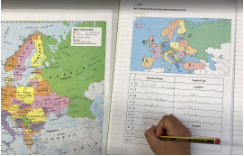
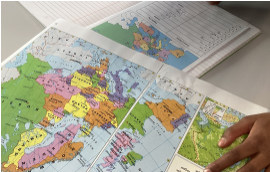
Update – Friday 28th November 2025
Thank you so much to everyone who made it to our Art Showcase this week — it was wonderful to see you all there, enjoying the moment with your children. We’ve had a wonderfully productive week in Year 3, with the children showing great enthusiasm and focus across all their lessons. They’ve really impressed us with their curiosity, teamwork and willingness to tackle new challenges. From deepening their understanding of maths to exploring patterns in art and developing thoughtful ideas in RE and History, it’s been fantastic to see their confidence continue to grow. We’re excited to share some of the highlights from this week’s learning below.
In English, Year 3 continued their Stone Age Beasts unit by focusing on organising information clearly and making their writing flow smoothly. The children worked on improving cohesion, sorting, and ordering sentences about the woolly mammoth to build meaning logically. They then revisited conjunctions such as because, when and even though to help them link ideas together and explain information in greater detail. Finally, they explored how pronouns like it and this can be used to avoid repetition and make their writing sound more natural. These small steps are already helping the children prepare for their own information pages later in the unit.
This week in Maths, we continued our work on Multiplication and Division. The children explored equal groups in more depth and used arrays to help them understand and represent multiplication facts. They worked hard to link repeated addition with multiplication and applied their knowledge to solve a range of problems.
In Art, Year 3 moved on to the Innovate stage of our Prehistoric Pots unit. The children began by sketching their own Beaker-style pot designs in their sketchbooks, taking inspiration from the shapes and patterns they explored earlier in the topic. They thought carefully about repeating patterns, lines and textures before bringing their ideas to life using clay. Using skills they practised over previous lessons — such as rolling, pinching, joining and smoothing — the children shaped their own pots with real care and creativity. The results were fantastic, and the children were incredibly proud of their finished pieces.
Update - Friday 21st November 2025
We’ve had a wonderfully productive week in Year 3, with the children showing great enthusiasm and focus across all their lessons. They’ve really impressed us with their curiosity, teamwork and willingness to tackle new challenges. From deepening their maths understanding to exploring patterns in art and developing thoughtful ideas in RE and History, it’s been fantastic to see their confidence continue to grow. We’re excited to share some of the highlights from this week’s learning below.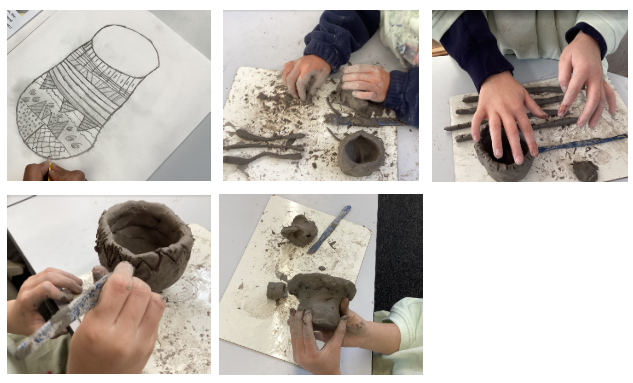
In English this week, we began our next sequence of lessons focusing on cohesion in non-fiction writing. The children explored how to organise information clearly by sorting sentences into logical sections, thinking carefully about how ideas link together. They also revisited key grammar skills, including using conjunctions to extend sentences, choosing pronouns to avoid repetition, and adding clauses to provide extra detail. Towards the end of the week, they recapped how to use apostrophes for singular possession. These skills will all help them prepare for writing their own information pages about Stone Age animals later in the unit.
This week, we began our new White Rose unit on Multiplication and Division. The children worked through the first five lessons, exploring equal groups, repeated addition and the connection between the 2, 4 and 8 times tables. They used practical resources and visual models to deepen their understanding and showed great determination as the concepts began to build. It’s been lovely to see their confidence grow as they started applying these skills in their independent work.
In Art this week, the children continued their work on styles and patterns. They explored how artists use repeating shapes, lines and colours to create striking designs, and experimented with different techniques in their sketchbooks. The children really enjoyed trying out their own patterned motifs and developing more control in their mark-making. It was fantastic to see them becoming more confident in discussing the choices they made in their artwork.

In RE, we continued our Living Difference IV unit on Angels. This week, the children explored Session 3, which focused on what angels might be like and on their own definitions. They shared thoughtful ideas about how angels are described in stories and what they might represent for Christians today. It was brilliant to see them reflecting so carefully and building on each other’s ideas.
Update - Friday 14th November 2025
It’s been another busy and exciting week for Year 3! The children have shown great enthusiasm across all their subjects — from exploring new historical discoveries to getting hands-on in DT. It’s been wonderful to see their growing confidence, teamwork and curiosity as we move further into our autumn learning.
In English, Year 3 continued their Stone Age Beasts unit, focusing on making their writing clear and cohesive. The children revisited conjunctions such as because, when and even though to help them link ideas smoothly, and explored how pronouns and clauses can make their sentences flow more naturally. They also practised using apostrophes correctly and worked together to improve sentence order and structure. It’s been a great week of building confidence as writers — and their information pages about Stone Age animals are really starting to take shape!
In Maths, Year 3 revisited their Addition and Subtraction unit, focusing on building accuracy and confidence when using written and mental strategies. The children practised estimating answers and using the inverse to check their work, showing great perseverance when tackling multi-step problems. They also refined their use of the column method, carefully lining up digits and remembering to carry when needed. It’s been great to see how their understanding has deepened and how confidently they can now explain their methods.
In DT, Year 3 continued their Cook Well, Eat Well unit by putting their cooking skills to the test and making Ratatouille. The children worked carefully to chop, slice and prepare a colourful selection of vegetables, focusing on using utensils safely and hygienically. They followed their recipes step by step, showing great teamwork and concentration as delicious smells began to fill the classroom! Once cooked, everyone enjoyed tasting their creations and discussing the flavours, with some children even surprised by how much they liked it. It was a fantastic combination of cooking, creativity and healthy eating!

In Geography, Year 3 continued their One Planet, Our World unit by learning about longitude and latitude. The children discovered how these imaginary lines help us to locate places on a globe or map and enjoyed using atlases to find countries along the Equator and the Prime Meridian. They were fascinated to see how these lines divide the Earth into hemispheres and how explorers and pilots rely on them for navigation. There was plenty of excitement (and a few “aha!” moments) as the children realised they were becoming real map-reading experts
In History, Year 3 explored what life was like at the end of the Bronze Age. The children learnt how new discoveries and changes in technology began to shape communities and prepare the way for the Iron Age. They examined how trade, tools and farming continued to develop and discussed what these changes meant for people’s daily lives. There were some thoughtful comparisons with earlier periods, and the children showed great curiosity about how quickly life was evolving in prehistoric Britain.
Update – Friday 7th November 2025
It’s been lovely to welcome all of Year 3 back after the half-term break! The children have returned full of energy, smiles and plenty of stories to share. We’ve been really impressed with how quickly everyone has settled back into routines and picked up their learning where they left off. It already feels like Year 3 has hit the ground running this half-term — with lots of exciting topics, creative lessons and hands-on activities ahead!
In English, we began our new non-fiction unit, Stone Age Beasts, linking perfectly with our History topic. The children were fascinated by prehistoric animals like the woolly mammoth and the giant lemur. They practised their speaking skills by becoming mini David Attenboroughs, narrating short “documentary” clips with expression and confidence. Later in the week, they explored new vocabulary from the text, created a class glossary, and identified key features of non-fiction writing. It’s been a great start, with plenty of excitement for writing their own information pages soon!
In RE, Year 3 began their new unit on Angels, exploring the Communicate step of the Living Difference IV cycle. The children shared their own ideas about what angels might be — where they come from, what they do, and what they might look like. Working in groups, they created colourful concept maps and sketches to express their thoughts and beliefs. It was lovely to see such imaginative ideas, from traditional angels with wings and halos to modern interpretations symbolising kindness and guidance. The children listened respectfully to one another and showed genuine curiosity about how different people understand the idea of angels.
This week in Geography, Year 3 learnt about tectonic plates and how they shape the Earth’s surface. The children discovered that the planet’s crust is made up of huge plates that move very slowly beneath our feet. Using maps and practical demonstrations, they explored how these movements can create mountains, volcanoes and even earthquakes. There was plenty of curiosity (and a few gasps of surprise!) as they realised just how powerful these natural forces can be.
In History, we continued our Through the Ages topic by learning about the Amesbury Archer, a fascinating archaeological discovery from the Bronze Age. The children examined different pieces of evidence found in his grave — including tools, jewellery, and pottery — and discussed what these items might tell us about who he was and how he lived. Working like real historians, they made thoughtful assumptions and shared their own theories, considering what life might have been like thousands of years ago. There was plenty of lively discussion and some very impressive detective work as they pieced together clues from the past!
In Art, the children have continued their Prehistoric Pots unit, which links perfectly with our history topic on the Beaker people. This week, they explored clay — discovering how it feels, moves, and changes shape when worked in different ways. Using a variety of techniques such as rolling, pinching, coiling and smoothing, the children experimented with creating different textures and forms. There was lots of excitement (and a fair bit of clay on the tables!) as they tested which methods worked best for shaping and joining pieces together. It was wonderful to see their creativity and growing confidence as young sculptors!

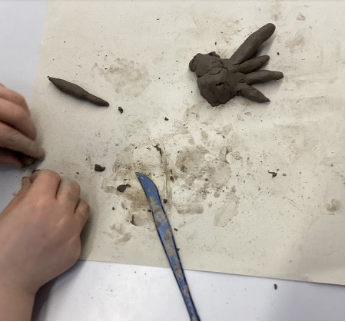
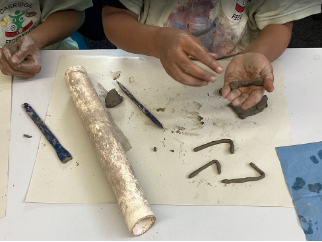
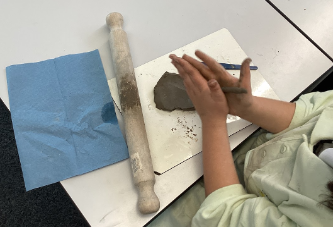
Update - Friday 24th October 2025
We’ve all been very proud of the children this week. Despite a few tired faces and the usual wave of autumn germs making their way around school, the children have continued to impress us with their perseverance and positive attitude towards learning.
This week in English, the children planned and wrote their final pieces, retelling the second part of Anansi the Clever Spider. They brought together all the writing skills they have been developing over the unit to create detailed and engaging stories. Afterwards, they carefully edited their work, using the English marking code as a guide to help them spot areas for improvement. It was wonderful to see how thoughtfully they responded to feedback — checking punctuation, improving word choices, and making sure their stories were clear and exciting to read.
In Art, we began our new topic, Prehistoric Pots, linking beautifully with our history work on the Beaker people. The children explored examples of ancient Beaker pottery, noticing the shapes, patterns and decorations that made each piece unique. They were fascinated to learn how these pots were hand-made and used for everyday tasks thousands of years ago. Using these designs as inspiration, the children then created detailed sketches in their art books, carefully adding texture and pattern to reflect the distinctive Beaker style. There were some very impressive artists at work — and plenty of proud smiles by the end of the lesson! 
In DT, we continued our Cook Well, Eat Well unit by putting our knowledge of cooking utensils into practice. This week, the children worked in small groups to prepare and cook a variety of different potatoes. They practised using utensils safely and carefully, showing growing confidence when peeling, chopping, and mashing. Once cooked, the children took part in a taste test to compare the different textures and flavours. There was plenty of discussion about which type of potato they preferred — and a few surprised faces when some discovered they liked one they’d never tried before!

In Science, we continued our learning on Animal Nutrition and the Skeletal System by exploring the different types of skeletons found in the animal kingdom. The children discovered that some animals, like humans, have endoskeletons (internal skeletons). In contrast, others, such as insects, have exoskeletons, and a few creatures, like jellyfish, have no bones at all — known as hydrostatic skeletons. There were lots of “wow” moments as the class compared how these different structures help animals to move, grow and stay protected. The children enjoyed sorting animals into the three skeleton groups and were fascinated to realise just how many ways nature has designed living things to stay strong and mobile!
Update - Friday 17th October 2025
We’ve all been very proud of the children this week. Despite a few tired faces and the usual wave of autumn germs making their way around school, the children have continued to impress us with their perseverance and positive attitude towards learning.
In Maths, the children have been deepening their understanding of addition and subtraction. They explored how to bridge across hundreds and tens, used number lines to check their thinking, and practised using mental strategies to solve problems efficiently. By the end of the week, they brought all their learning together to tackle the column method — lining up digits carefully and remembering to carry when needed (with some very proud “lightbulb” moments along the way!).
In history, we have waved goodbye to the Stone Age and stepped confidently into the Bronze Age! The children learned about how the arrival of the Beaker people changed life in Britain — from farming and tool-making to the creation of impressive burial mounds. To end the lesson, we held a lively “hot seating” session where one brave child became a Beaker person, and the rest of the class turned into curious historians, asking thoughtful questions about what daily life was like all those years ago. There were some excellent performances and even a few accidental Bronze Age accents!
Our PSHE lessons this week focused on empathy. We began with the story The Only Way is Badger, which helped the children reflect on how it feels when someone only thinks about what they want. They then watched a fun Sesame Street clip featuring Mark Ruffalo (better known to the children as the Hulk!) explaining empathy in a way that really made them smile. We finished the lesson by thinking of real-life examples of empathy we’ve seen around school — and there were plenty to celebrate!
In science, we’ve been learning all about joints and muscles in the human body. The children discovered that muscles work in pairs — when one muscle contracts (tightens), the other relaxes — a bit like a team doing a perfect push-and-pull routine! They carried out fun activities to see this in action and were amazed to realise just how many muscles are needed for simple everyday movements like bending an arm or jumping.
Update - Friday 10th October 2025
As we reach the halfway point of the half term, the children are continuing to show great focus and enthusiasm in their learning. They’ve enjoyed exploring new ideas across the curriculum this week – from writing stories inspired by Anansi, to learning how our planet changes beneath our feet. It’s been another week full of curiosity, creativity and thoughtful discussion.
This week in Maths, the children have been deepening their understanding of addition and subtraction. They’ve been learning how to estimate answers, use the inverse operation to check their calculations, and solve missing number problems by thinking logically and applying what they know about number relationships.
We’ve been using bar models and number lines to help represent problems visually, which supports both understanding and accuracy. The children have shown great perseverance when tackling trickier questions and have been encouraged to explain their thinking clearly using full sentences – a key skill in developing confident mathematical reasoning.
In RE this week, the children deepened their understanding of symbols by looking more closely at the use of trees in religious stories. We watched videos that showed how trees are mentioned throughout the Bible, often as symbols of life, strength, wisdom, or choices between good and evil – such as the Tree of Knowledge in the Garden of Eden.
This week, the children were introduced to some exciting new learning in Geography as we explored the concept of plate tectonics for the first time. We began by learning that the Earth's surface is made up of huge slabs of rock called tectonic plates, which are constantly moving — although far too slowly for us to notice!
The children discovered how these movements can cause dramatic changes to our planet, including the formation of mountains, volcanoes, and earthquakes. We used diagrams, models, and videos to help bring these big ideas to life, and discussed real-world examples of where plate movements have shaped the land.
To help build their understanding, the children worked in groups to match new scientific vocabulary to pictures and definitions, making great links between cause and effect. This was a fascinating and thought-provoking session that really sparked their curiosity about the natural world.
In History, the children explored Stone Age monuments and discovered how early humans built impressive structures using only simple tools. We looked closely at examples such as Stonehenge, Skara Brae, and other stone circles, thinking about what they might have been used for and why they were so important to the people of the time. The children then carried out research about Stonehenge to find out more about how and why it was built, before answering questions to show their understanding. To finish, they used equipment from their tables to recreate their own version of Stonehenge, showing great teamwork and creativity as they imagined what it might have been like to build such a monument thousands of years ago.
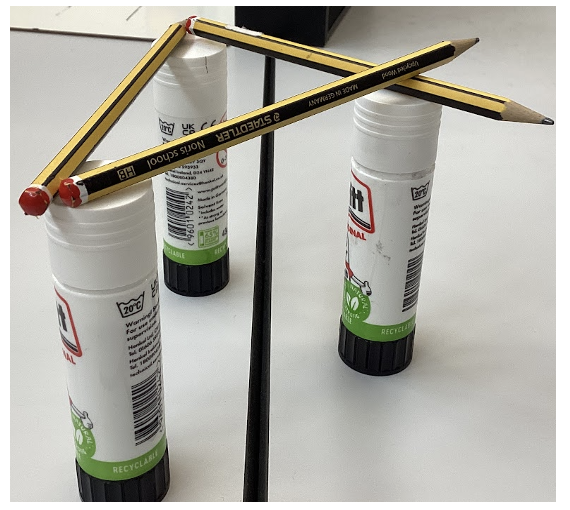
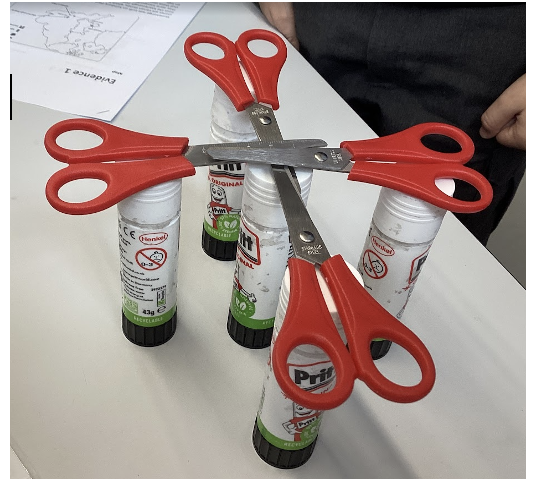

Update - Friday 3rd October 2025
The children have continued to work brilliantly this week and have produced some terrific learning across all subjects. They’ve shown growing independence and creativity, and we’re very proud of how they’re developing as learners.
This week, we started our new English unit based on the traditional tale Anansi the Clever Spider. The children listened to the story and then worked together to come up with actions to help them remember it. This fun, active approach helped embed the structure and key phrases of the tale, ready for their retelling later in the unit. They’ve also been introduced to how speech is written in stories using inverted commas (speech marks) and have started experimenting with using dialogue in their own writing. We’ve been working on up-levelling sentences too – the children were shown how to take a basic sentence and improve it using more exciting vocabulary, adjectives and expanded noun phrases. This supports their confidence as writers and helps them make more deliberate word choices to enhance meaning.
In Maths, we began our new unit on Addition and Subtraction. The children have been learning how to: - Add and subtract ones, tens and hundreds from 3-digit numbers - Use number lines to count forwards and backwards - Partition numbers to support mental strategies - Recognise number patterns and identify which strategies to use in different situations They’ve shown fantastic perseverance, especially when using structured representations like bar models and number lines to support their reasoning.
Our Through the Ages topic continued this week with a focus on Stone Age settlements, especially the fascinating site of Skara Brae. The children examined images and artefacts to learn how people lived during this time, from how they used fire for warmth and cooking, to the types of animals they hunted for food and clothing. We also introduced the idea of primary and secondary sources, helping the children understand the difference between real-life evidence and later interpretations made by historians.
In Geography, the children built on their mapping skills by learning about compass points. They used the four main directions – North, East, South and West – and then extended their knowledge to include the intermediate compass points like North-East, South-East, South-West and North-West. The class enjoyed a range of activities to practise using compass directions to find their way around a map. These tasks helped develop their understanding of spatial awareness and positional language in a real-world context.
Update – Thursday 25th September 2025
Although the children have only been in school for four days this week, they have worked incredibly hard and produced some fantastic work across the curriculum.
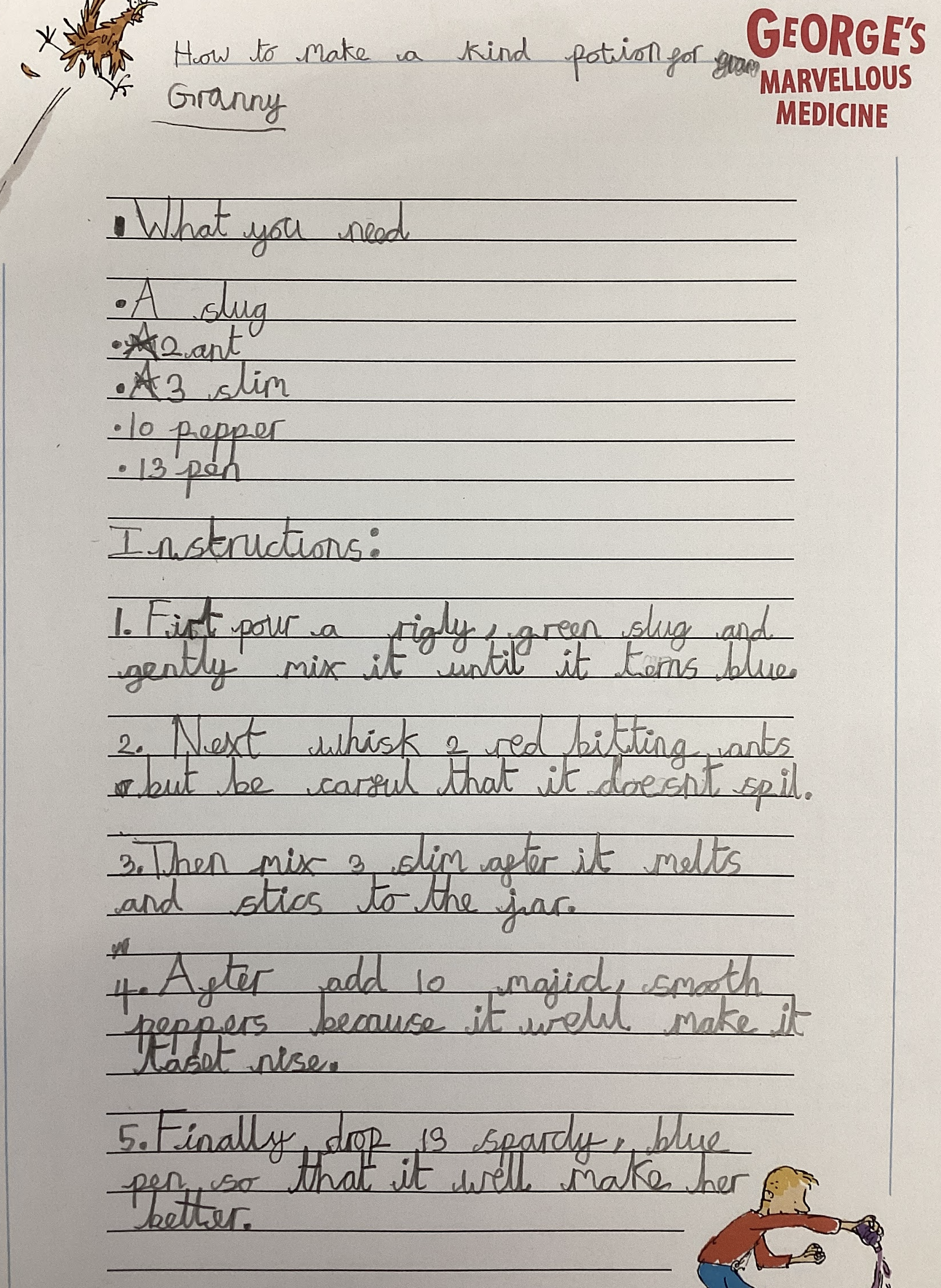 This week in English, the children brought their imaginative ideas to life by writing their own set of instructions for a marvellous medicine, inspired by George’s Marvellous Medicine. Using their planning notes, they included key features of instructional writing such as imperative verbs, time adverbials, numbered steps and clear sequencing. The children then edited and improved their final piece using our school marking code. It was brilliant to see how confidently they applied their learning and took ownership of their writing.
This week in English, the children brought their imaginative ideas to life by writing their own set of instructions for a marvellous medicine, inspired by George’s Marvellous Medicine. Using their planning notes, they included key features of instructional writing such as imperative verbs, time adverbials, numbered steps and clear sequencing. The children then edited and improved their final piece using our school marking code. It was brilliant to see how confidently they applied their learning and took ownership of their writing.
In Maths, we completed the final part of our Place Value unit using the Year 3 White Rose Maths scheme. This week, the children practised comparing and ordering numbers to 1,000, finding 1, 10 or 100 more or less, and working with number lines. They also developed their reasoning skills through problem-solving tasks that encouraged deeper thinking. The class made excellent progress and are now well-prepared to begin our next unit on addition and subtraction.
In History, we continued exploring our topic, Through the Ages, by learning about everyday life in the Stone Age. The children considered how early humans hunted, gathered food, built shelters and made tools. They then wrote diary entries in the role of someone living in the Stone Age, using what they had learnt to describe the daily challenges and experiences of prehistoric life. This creative task helped to deepen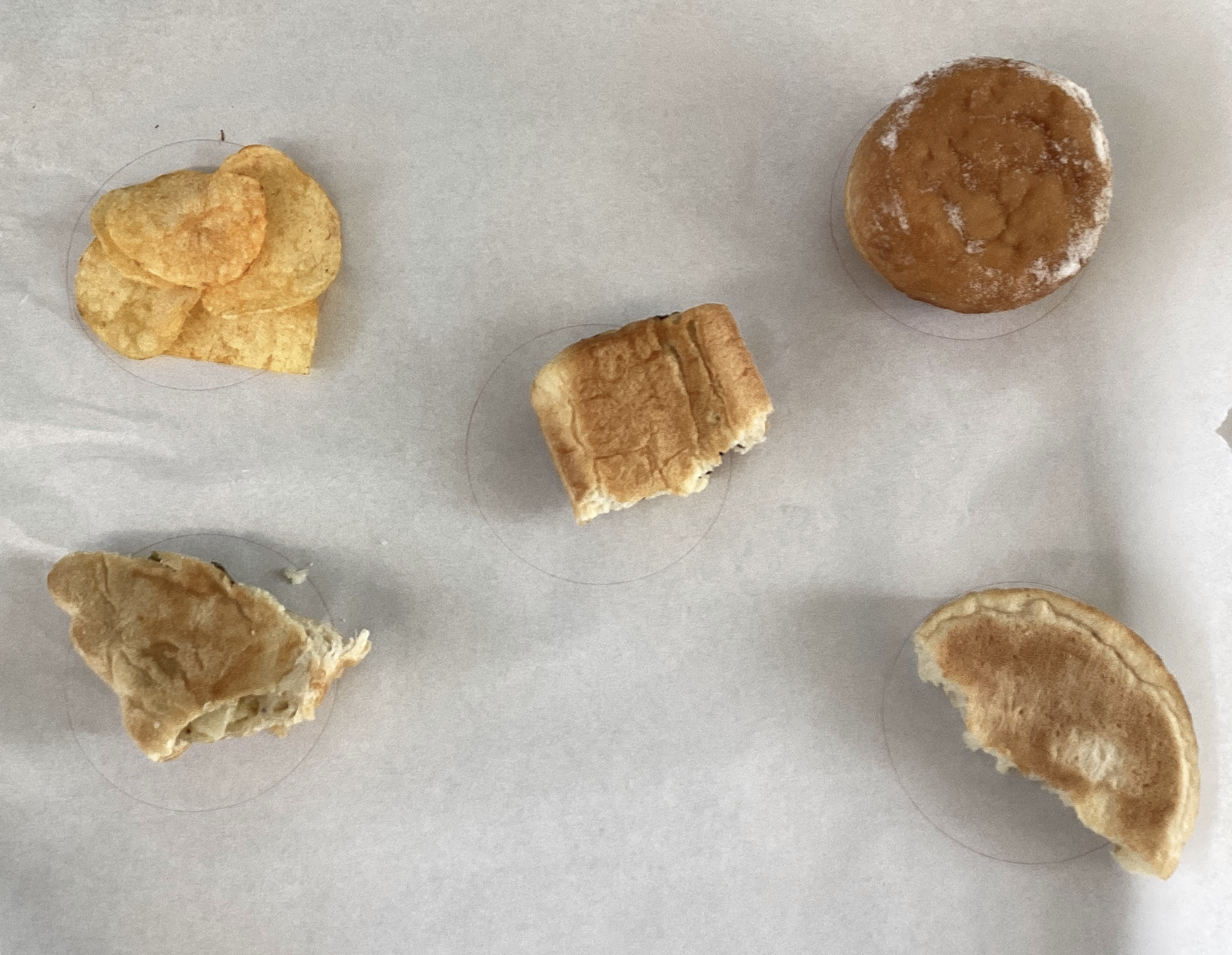 their understanding of the period.
their understanding of the period.
In Science, the children carried out a practical investigation to find out which foods contain the most fat. After making predictions, they tested a range of food items by leaving them on blotting paper and checking for grease marks. The class recorded their results carefully and answered questions using the evidence they had gathered. This experiment supported their learning about nutrition and helped them better understand how different foods affect the body.
Update – Friday 19th September 2025
The children have continued to be amazing this week, showing great enthusiasm and resilience as they tackle new learning across the curriculum. We’re so proud of how hard they are working and how well they are settling into Year 3 routines.
In English, the children have been preparing to write their own set of instructions for a marvellous medicine, inspired by our focus book, *George’s Marvellous Medicine*. This week, we explored how using conjunctions can improve instructional writing by adding more detail and clarity. The children practised combining ideas and giving more precise explanations to help their readers understand each step.
In Maths, we continued our work on place value. This week’s focus was on identifying missing numbers on number lines. The children worked through a series of steps to help them estimate and calculate which numbers should go where. This supported their understanding of number sequences, intervals, and logical reasoning.
Our History topic 'Through the Ages' continued with a hands-on activity using prehistoric picture cards. The children used the images to explore what life might have been like during the Stone Age, making thoughtful observations and drawing comparisons to modern-day life. They examined closely how people hunted animals for food and clothing, and how the discovery and use of fire helped transform life in the Stone Age.

In RE, we’ve continued to explore how symbols are used in Christianity. This week, the children reflected on how trees are mentioned in the Bible and the deeper meanings they can represent. For example, we discussed how a tree might symbolise strength, growth, or wisdom, and how these meanings can be personal or spiritual.
In PSHE, under the theme *Being Me in My World*, we looked at the importance of rights and responsibilities in society. The children discussed how these two ideas are linked, and why it’s important for everyone to take responsibility for their actions to help make our class and community a fair, respectful place.
Update – Friday 12th September 2025
A Fantastic First Full Week! We’ve all been incredibly proud of how well the children have settled into Year 3 during their first full week back. They’ve shown fantastic enthusiasm across all areas of the curriculum and have produced some truly impressive work. It’s been lovely to see their confidence and independence already beginning to grow.
In English, the children continued developing their knowledge of instructional writing. They focused on what makes a good set of instructions and began drafting their own apprentice pieces. A new grammar focus this week was quantifying determiners – words such as 'some', 'many', 'several', and 'each', which help us describe amounts more precisely. We also introduced the children to using a thesaurus to improve their vocabulary. They really enjoyed finding more interesting and ambitious adjectives to enhance their writing!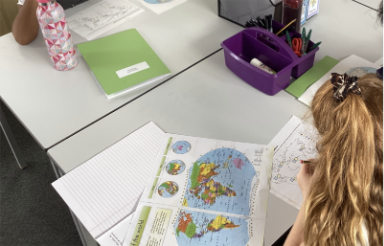
In Geography, we began our new unit, 'Our Planet, Our World', with an exciting first lesson. The children explored a variety of maps to identify the seven continents, five oceans, and key countries around the world. They practised finding different countries and their capital cities, helping them build their understanding of global geography and the layout of our world.
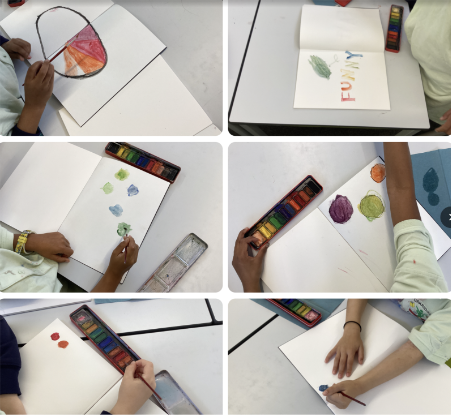
This week in Art, the children began their new unit on colour theory. In this first 'Engage' lesson, they experimented with colour in a range of creative ways. Some children created their own colour wheels, learning how primary colours mix to make secondary colours. Others explored the difference between warm and cool colours, discussing how colours can create different moods and feelings. A few groups also investigated contrasting colours and how these can be used effectively in artwork. It was a hands-on session full of creativity, with lots of thoughtful discussion and beautiful outcomes!
Update – Friday 5th September 2025
It’s been a very exciting first few days back at school, and we’re so proud of how well the children have settled into their new classes. They’ve adapted brilliantly to the new junior school routines, including navigating the new routes around the building. Next week, we’ll continue establishing routines, such as taking reading books home and logging in to use TT Rockstars for times tables practice.
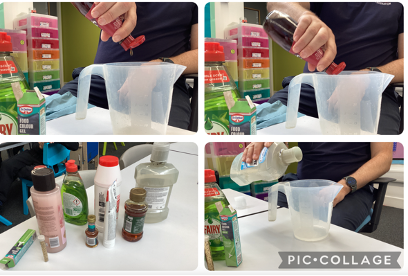 In English, the children have started a unit on instructional writing, building on what they learnt last year in 'How to Wash a Woolly Mammoth'. They remembered the importance of making their instructions clear and concise. We also recapped imperative verbs (bossy verbs like “put,” “get,” or “mix”) and introduced a new grammar focus: determiners – words like “the,” “a,” “some,” and “this” that come before a noun.
In English, the children have started a unit on instructional writing, building on what they learnt last year in 'How to Wash a Woolly Mammoth'. They remembered the importance of making their instructions clear and concise. We also recapped imperative verbs (bossy verbs like “put,” “get,” or “mix”) and introduced a new grammar focus: determiners – words like “the,” “a,” “some,” and “this” that come before a noun.
In Religious Education, we began exploring the concept of symbols. The children discussed the difference between a symbol and a logo, sorting familiar images and explaining how symbols can carry deeper meanings, while logos usually represent brands or companies.
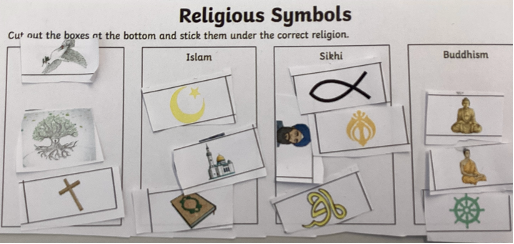
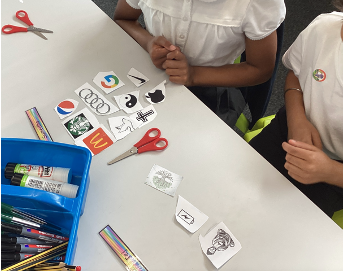
Our history topic this half-term is the Stone Age. We began by examining timelines and learning key vocabulary related to time and chronology. The children also learnt about the three different periods of the Stone Age and worked together to put them in the correct chronological order.
